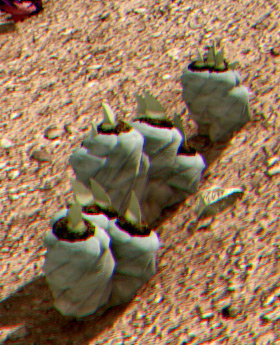By Jane Eastwood, XRI Lead Exobiologist
Why are many of the photobionts we see on Artocos so superficially similar to Earth's desert plants? If it weren't for the lavender and bright red pigments, they wouldn't get a second glance if they were seen in Earth's deserts. (Well, I'd glance twice at them, because I glance twice at every plant.) They're squat and barrel-shaped and covered in spines - just like a cactus, or one of the Euphorbia found in the Sahara.
 |
 |
 |
For that matter, why do the cacti of the American deserts look so much like the Euphorbia of Africa? The answer is convergent evolution.
There are certain traits that are really awesome competitive advantages - like wings, or flippers, or eyes that focus, or leaf hairs that can wick the water in fog out of the air. Wings have evolved many times - at least once in insects, and then in pterodactyls, birds, and bats. The anatomy of these wings differs - in bats, skin held taut across long delicate fingers forms the airfoil, in insects it's a flat, thin, highly modified leg, and in birds it's feathers - stiff dermal scales spread below the forelimb bones. These structures have vastly different evolutionary histories, but the result is the same: they can fly.
While the results here are less spectacular than flight, our photobionts exhibit convergent evolution because the traits of cacti, aloe, sedum, and euphorbs are very useful in a dry environment. Water is precious, so these organisms have limited surface area - instead of costly giant leaves they have a delightful cylinder shape or thick paddle-like organs. The whitish tinge of many species is from thick waxy coats that protect their delicate internal tissues or thousands of tiny white hairs that minimize water loss via evaporation. Accumulating water and nutrients in a desert is hard work, so spines and nasty chemicals prevent grazers from eating all or most of an organism. (and yes, we haven't found nasty chemicals yet because the spectrometer's broken. I'm theorizing.)
We don't know the evolutionary processes that led to the development of these traits - I'm particularly interested in the spines, because on Earth most spines are derived from ancestral leaves, and there are no apparent ancestral leaves here - but we do know why some of the photobionts wouldn't look out of place in a line-up of Earth's desert plants.
